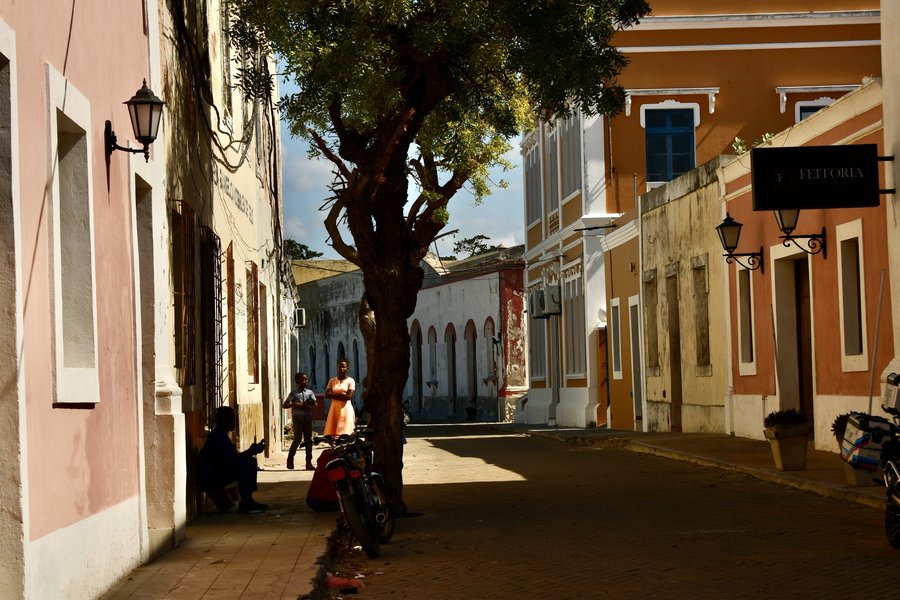
Visit July 2025.
Although listed as a UNESCO World Heritage Site since 1991, Ilha de Moçambique, just a few handful of members from the community have made it here.
We flew into Nampula from Johannesburg and made our way to the island. We stayed at Jardim dos Aloés, a beautifully restored 17th-century Portuguese house, now a charming guesthouse, owned by Bruno, an Italian. With its high ceilings, vintage details, and leafy courtyard, it was the perfect base for our time on the island.
The island itself is 3 km long and 500 m wide. The whole island make up the core zone. The island is roughly split in two: Stone Town, the historic colonial core, where the Portuguese elites once lived; and Macuti Town, where most of the local population still live today.
Stone Town
On our first day, we explored Stone Town with our guide, Amisse, who gave us a deeper understanding of the island. A highlight was the former Governor’s House, now a museum with a preserved collection of colonial-era furniture. Originally built by Jesuits and later taken over by the Portuguese, the building served as the capital’s governor’s residence. One room was even furnished for the King of Portugal — though he never came. The only person who ever slept in the royal bed was Mozambique’s first president, during a national tour. He later declared the building a museum — likely saving it from being looted during the civil war. The church’s altar inside is currently under restoration.
Next was the imposing Fortaleza de São Sebastião — the largest of the Portuguese forts in Africa. Its sheer size is impressive, and inside (or rather outside, facing the sea) is the small chapel of Nossa Senhora do Baluarte, one of the oldest European buildings in the southern hemisphere, also currently under restoration.
The fort is built with inspiration from the italian principles and also with advice from Vaubau. It was massiv and has never been concurred
Another landmark was the old hospital, once a grand building with over 300 beds. Though badly damaged by a cyclone, its majestic structure still stands but in decay.
Wandering around the island was peaceful, and unhurried. There’s very little traffic and not many tourists to see. The streets are wide, not narrow like Lamu or the other famous Stonetown, and flanked with old colonial houses.. Some colonial houses have been lovingly restored — mostly owned by foreigners — while others remain in decay. The island has a calmly atmosphere. At night, with almost no artificial light, it is possible to enjoy the beautiful night sky.
Macuti town
The next day, we went to Macuti Town, with the same guide on a bike. He is living here himself with his family and seems to know everyone. When the Portuguese built their fort and stone town, they quarried the coral rock directly from the island, creating a vast depression in the landscape. Macuti Town grew up in this sunken area, a sort of “bowl” below ground level, making it even more vulnerable to flooding.
Approximately one-third of Ilha de Moçambique is occupied by Macuti Town—built in Swahili style using local materials like mud walls, bamboo, and macuti (dried palm leaf) roofs. But today, traditional techniques are becoming increasingly rare. Most residents build with whatever they can find or afford. Many homes are now constructed with bricks, and if resources allow, they install corrugated iron roofing instead of macuti. I suppose the authenticity of Macuti Town is under threat— from changing materials and construction styles that don’t necessarily align with UNESCO’s conservation guidelines?
Macuti is densely populated and under pressure. Many homes have been damaged or destroyed by cyclones, the most recent one hitting especially hard. People live with limited access to clean water, sanitation, or reliable housing. Most residents don’t have formal employment. They sell vegetables, fish, or small goods. We learned how each neighborhood - up to 80 people - functions almost like a cooperative economy. They pool resources and look out for each other. There is deep mistrust of banks, government, and outside aid. Despite international donations for cyclone relief, locals say they never saw any of the promised support. “Too much corruption,” they told us. “We take care of each other.”
Ilha de Moçambique is not a beach destination in the traditional sense, even though it holds some nice beaches and possibilities for snorkling and whale-watching. We enjoyed our visit here and found this to be one of the most unique and atmospheric towns in Africa in comparison with for example Stonetown (Zanzibar) or Lamu. A forgotten capital, that deserves more visitors.
More on
Comments
No comments yet.
